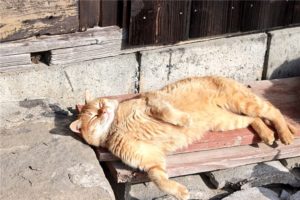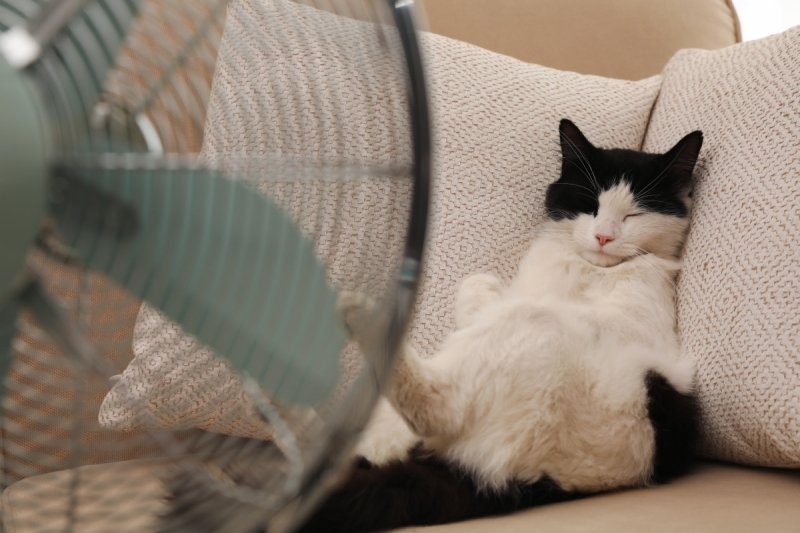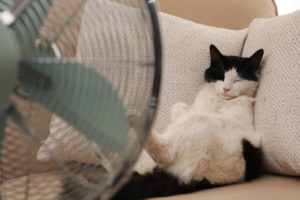Cats are known for their agility and resilience, but they are not immune to the dangers of heatstroke. While it may be less common in cats compared to dogs, heatstroke can still occur and pose a serious threat to their well-being. In this article, we will explore the symptoms of heatstroke in cats, the causes behind it, what to do in case of an emergency, and crucial preventive measures to keep your feline friend safe and cool during hot weather.

Understanding Heatstroke in Cats
Heatstroke, also referred to as prostration or hyperthermia, is a condition characterized by a rise in the core body temperature due to environmental factors. While a cat’s normal body temperature ranges between 101-102.5 degrees Fahrenheit, a temperature above 105 degrees Fahrenheit calls for immediate veterinary attention. Heatstroke in cats is primarily caused by exposure to excessive ambient heat, and some common triggers include:
-
Extremely hot outdoor temperatures
-
Lack of access to shade
-
Being trapped in a hot, unventilated space (such as a car)
-
Insufficient access to water
Recognizing the Signs of Heatstroke in Cats
It is crucial for cat owners to be aware of the symptoms of heatstroke to identify and address the condition promptly. If your cat is suffering from heatstroke, you may observe one or more of the following signs:
-
Excessive panting
-
Restless behavior
-
Sweaty feet
-
Vomiting
-
Lethargy
-
Muscle tremors
-
Drooling
-
Excessive grooming
-
Uncoordinated movement
-
Loss of balance
-
Seizures
-
Unconsciousness
Immediate Actions to Take
Heatstroke is a medical emergency that requires immediate attention. If you suspect that your cat is experiencing heatstroke, it’s crucial to act swiftly. Take the following steps to help your cat before seeking professional veterinary care:
-
Move your cat to a cool room: Transfer your cat to a cool area with sufficient airflow to aid in the cooling process.
-
Wet your cat’s fur with cool water: Gently wet your cat’s fur using cool (not cold) water. Avoid using ice-cold water as it may shock their system.
-
Apply ice packs to their feet: Place ice packs gently on your cat’s feet to help lower their body temperature.
-
Seek veterinary care: Transport your cat to the nearest animal emergency hospital or your regular vet as soon as possible. Keep the vehicle’s air conditioning on full or open the windows to ensure adequate airflow during transportation.
Veterinary Treatment for Heat stroke

Upon arrival at the veterinary clinic, the medical team will work to restore your cat’s body temperature to a normal range. This may involve various cooling techniques, such as using cool water and ice packs. Additionally, your vet may administer intravenous fluids to aid in temperature reduction, counteract shock effects, and minimize the risk of organ damage. In severe cases, oxygen therapy might also be necessary.
During the treatment process, your vet will closely monitor your cat’s body temperature until it returns to normal. It’s important to note that heatstroke can lead to organ damage and other complications, which may not become apparent immediately. Therefore, your vet will conduct a thorough examination to assess any potential long-term effects before allowing your pet to return home. Aftercare instructions will also be provided to ensure your cat’s full recovery.
Preventing Heatstroke in Cats
Prevention is always better than cure, especially when it comes to heatstroke in cats. By taking proactive measures, you can minimize the risk of your feline friend falling victim to this dangerous condition. Here are some essential tips to help prevent heatstroke:
-
Provide a cool, shady space: Ensure your cat has access to a cool, well-ventilated area with ample shade to retreat to on hot days.
-
Fresh water availability: Keep your cat hydrated by offering plenty of clean, fresh water at all times.
-
Never leave your cat in a hot vehicle: Never leave your cat unattended in a car, as temperatures can rapidly rise to dangerous levels even with the windows cracked open.
-
Avoid hot rooms: Keep your cat away from hot, unventilated rooms such as garages or attics, especially during scorching weather.
-
Consider indoor playtime: If outdoor temperatures are particularly high, engage your cat in indoor activities to avoid excessive heat exposure.
-
Monitor humidity levels: High humidity can exacerbate heat-related issues, so keep an eye on humidity levels and take extra precautions during humid conditions.
-
Cooling aids: Provide your cat with cooling aids, such as chilled ceramic tiles or cooling mats, to help regulate their body temperature.

Remember, the advice provided in this article is for informational purposes only and should not substitute professional veterinary guidance. If you suspect your cat is experiencing heatstroke or any other medical condition, it is crucial to consult with your veterinarian for an accurate diagnosis and appropriate treatment.
By implementing preventative measures and staying vigilant, you can ensure your beloved cat stays safe and comfortable even during the hottest days of the year. Stay informed, act promptly, and prioritize your feline friend’s well-being to enjoy many more summers together.

